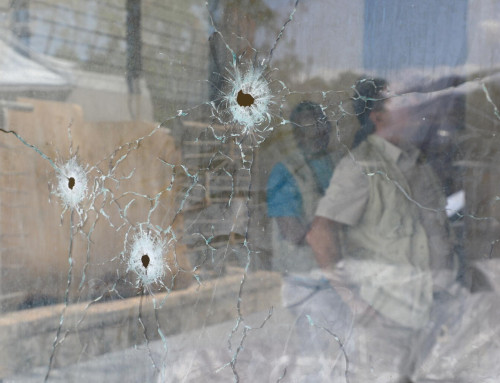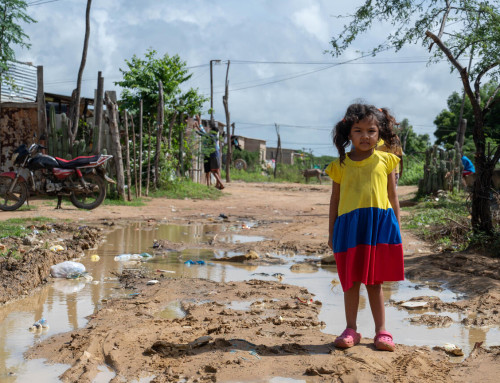21-Nov-01
FOR CHILDREN AND ARMED CONFLICT
In an effort to bridge the gap between declarations and practice, for the first time in history the Security Council had requested the Secretary-General to attach a list of those who recruited or used children in armed conflict to his next report on the matter, Olara Otunnu, Special Representative of the Secretary-General for Children and Armed Conflict, told correspondents at a Headquarters press briefing this afternoon.
Also participating in the briefing were Alhaji Babah Sawaneh, 14-year-old former child soldier from Sierra Leone, and Marie A. Manyeh, United Nations Children’s Fund (UNICEF) Assistant Project Officer, Child Protection, Sierra Leone.
Highlighting the outcome of yesterday s fourth debate of the Security Council — devoted entirely to the issue of the rights, protection and rehabilitation of children affected by conflict — Mr. Otunnu said that its decisions represented a major step towards the era of application . [At the second of its two meetings on children in conflict yesterday, the Council unanimously adopted resolution 1379 (2001), by whose terms it also expressed its readiness to continue to include child-protection advisers on peacekeeping operations, and asked the Secretary-General to take the protection of children into account in peacekeeping plans submitted to the Council. ]
The Council had also reiterated in explicit terms the importance of holding immunization days in the areas of conflict, Mr. Otunnu said. The Secretary-General of the United Nations had introduced his report on the matter. Statements were also made by Carol Bellamy, UNICEF Executive Director, as well as by
Mr. Otunnu himself. For the first time in the history of the Security Council, a non-official of the United Nations system, a child, had taken the floor.
He went on to enumerate issues discussed as a matter of priority. They included protection of girls at the time of conflict; correlation between war and the spread of HIV/AIDS; and the importance of making sure that no impunity was granted to the perpetrators of crimes against children in situations of conflict. Another important aspect of the problem was the fact that children were robbed of their birthrights through the plunder of resources of countries in conflict. Those resources should be used for the rehabilitation, education and healing of children.
An important threshold had been cleared only several days ago, he continued:10 ratifications were now in place, which were required for the Optional Protocol to the Convention on the Rights of the Child to enter into force next February.
Concluding his statement, Mr. Otunnu particularly underscored the need to respond to the situation in Afghanistan, focusing international efforts on the needs, the rehabilitation and the healing of children. The Security Council had been very clear on that issue.
Responding to a question about the vulnerability of young women in conflict, Mr. Otunnu said that yesterday, he had given an example of girls heading 60,000 parentless households in Rwanda. Another example was the abduction of children from Freetown, Sierra Leone, where 60 per cent of those abducted were girls. Some fighting groups continued to use women as workers of choice for suicide missions, like mine-clearing, for instance. Another example was the Balkans, where young girls were trafficked for prostitution. All that demonstrated the particular vulnerability of girls at the time of conflict. His appeal to the Council was for special measures to address that vulnerability.
Asked about the implications of the Security Council decisions for his Office, Mr. Otunnu said that almost immediately after the Council meeting yesterday, the International Soccer Federation (FIFA), UNICEF, his Office and the Secretary-General had launched arrangements to stop the fighting during the World Cup. That was a very concrete example. Come February, when the Optional Protocol would enter into force, it was necessary to ensure immediately that it had a bite on the ground. Up till now, the decision to observe the age of 18 for recruitment had been voluntary. As of February, the Optional Protocol would become a concrete instrument of advocacy and monitoring on the ground.
The Office was also working with the Secretary-General’s Special Representative for Afghanistan, Lakhdar Brahimi, and various funds, programmes and NGOs to ensure that children were at the forefront of international concerns in the context of the programmes for rehabilitation and relief in that country. Do not be surprised that there will be actual naming of names of parties in conflict which continued to recruit and use children in conflict in the report on children and armed conflict which his Office would prepare next year. Thus, the debate and the resolution adopted yesterday were pregnant with very concrete implications for the work of his Office.
Asked what the Office could do for the children of Afghanistan right now, Mr. Otunnu answered that numerous appeals and declarations had been issued by the Secretary-General, UNICEF and his Office, making it clear that in the conduct of the present campaign, all the protagonists must scrupulously observe all the standards of humanitarian law. If any parties were found committing crimes against children, it was necessary to hold them accountable. The Council had underscored that there must be no amnesty for those who committed grave crimes against children.
What age brackets were implied by children, a correspondent asked.
Mr. Otunnu replied that the Convention on the Rights of the Child defined a child as any person under the age of 18. That was a very precise notion. In the context of work on the ground, one should not draw too artificial a line, however, between children, adolescents and young people. In Afghanistan, for example, the war had been going on for some 23 years, and many people who had been children when the conflict started still suffered from the legacy of that period. Their needs should be addressed as well.
To a question about child volunteers, he said that the entire purpose of the Optional Protocol was to set universal standards. It did not matter if a person had volunteered or was forced to participate in conflict. The standard was that for insurgency groups, there should be no participation or recruitment below the age of 18. For national armed forces, no recruitment was allowed below the age of 16.
Asked if he was optimistic that the Council would act if names were named of those who used children in armed conflict, Mr. Otunnu said he had every confidence that it would. The world had become very interdependent, and nobody was immune from international pressure and public opinion. The weapons of naming and shaming should be used to protect children. It was also important to put into place a mechanism to monitor and report on a regular basis what parties to conflict were doing to children.
Addressing the former child soldier from Sierra Leone, a correspondent asked him to describe his experiences. Mr. Sawaneh said that he was 10 years old when he was abducted by rebels during a Christmas holiday visit to an uncle living in a village in the north of the country. The rebels took him to their base and recruited him there.
Asked if real war seemed like a movie to him, he said that at the base, on orders from the commanders, he had taken part in attacks.
Mr. Otunnu added that yesterday, Mr. Sawaneh had described his experiences to the Council. He had been forced to both experience and do some terrible things, and certainly that experience was nothing like a movie.
To a question about efforts to help the children in Sierra Leone, Ms. Manyeh replied that children were disarmed, demobilized and rehabilitated through the DDR process. Children spent about six weeks at the DDR centres. Recreational activities and informal education were among the activities there. Most importantly, they were registered for family reunification. If the families were found and there were no acute behavioural problems, children were reunited with their relatives. There was also some follow-up to see how they were doing afterwards. Those whose families could not be traced in 6 weeks, were placed in foster homes. Rehabilitation was an important aspect, for it was important to teach them some skills and make them useful members of society.
There were two categories of children, she continued: those who had been separated from their families and those who had been recruited. It was easier for the separated children to be reunified with their families. As for the child soldiers, they were sometimes rejected by their families and it was more difficult to reintegrate them into communities. In her experience, the majority of children did fit into society as time passed. Some remained with foster families, however.
Mr. Otunnu added that in some cases, there was a phenomenon of rejection by families, communities, or schoolmates. It was important to sensitize the families and the communities to the needs of the child soldiers, making them aware that no matter what circumstances they found themselves in, they had been victimized themselves. They needed care and protection.
The second challenge was that the level of resources for rehabilitation and recovery programmes was nowhere near the needs, he said. In Sierra Leone, for example, the armed groups had finally begun to take his Office seriously when told they must release the children. About 4,000 children had been released, but there were no resources to take care of those children. Now the international community must back its declarations with resources.
Asked about funding, Mr. Otunnu said that children were robbed of the benefits that the natural resources of their countries should have ensured. There was something wrong with the situation where the diamonds, gold and other natural resources in Angola, the Democratic Republic of the Congo and Sierra Leone were not going towards the needs of the children, when they were dying and there
were no schools or health facilities in those countries. The issue had been reflected in the Council debate and the resolution yesterday.
Asked what could be done to stop the commanders from forcing the children to fight, Mr. Sawaneh said that the commanders themselves did not understand the situation. He would not be able to answer the question.
Mr. Otunnu said that in Sierra Leone, the abduction and use of child soldiers had no support within the community.
Ms. Manyeh added that in fact, resentment over the use of child soldiers in Sierra Leone was one of the reasons community civil defence forces had emerged there. Currently, there was a multifaceted approach to the problem, with the creation of the International Criminal Court, the coming into force of new international instruments and awareness-raising efforts on behalf of the international community.
This is a problem we can crack, Mr. Otunnu said. We need standards that are clear and universal. Thank goodness, as of February, we shall have that in place. That is a big milestone. As for advocacy and pressure, it had to be applied at the national, local and international levels.





